Leah | She/Her | Freelance Fantasy Editor | Speculative Fiction Author | Welcome to the Writer's Craft Corner! You'll find posts on writing and editing here. | Main Blog: @lnrambo
Don't wanna be here? Send us removal request.
Text

Editing Tip #5: Editing for Variation
A couple of line and copyediting tips to help you make your story shine. ✨
Hey Story Crafters,
Fall is in the air! The days are getting shorter and cooler, and pumpkin spice is back on the menu. I’m not really a fan of cooler weather, but low humidity and crisp air is pretty nice.
In this post, I want to cover a couple of line and copyediting tips that you can use during revision to help make your story shine even more. These tips are best used after you’re confident in and happy with your story from a big-picture level (in other words, after all the developmental editing is done).
If you’re just starting out as a writer, this might be a higher level of self-editing than you want to tackle at this point of your career. You still might want to check out the following tips, just to see if you want to add them to your self-editing toolbox to use in the future.
Word Choice Variation
Ever sit down to revise your story, switch out a word to introduce a little variation (like switching “amazing” to “awesome”), only to realize that you used that word earlier in the same paragraph? Or even just in the previous sentence?
It happens to me a lot as a writer. And it can happen during revision, or during the initial process of writing (because we all have a few words that we tend to fall back on and overuse). There are words that are expected to be frequently used (e.g., “and”, “said”, “the,” etc.), and because they are used so frequently, they tend to fade into the background. They don’t draw attention to themselves. But then there are less frequently used words that do draw attention, which makes it more obvious when they are used close together.
This is where the Search/Find function in your word processer comes in handy. Just type in the word you want to search for, and review how frequently that word appears in your story, and where that word appears. Depending on the results, you might want to consider switching up your word choice.
Sentence Length Variation
If you want to experiment with tone and mood, varying the length of your sentences can give you different effects, depending on what you’re going for.
For example, long, flowing sentences can help give a sense of continuous movement.
On the other hand, if you’re going for bursts of impact, short, punchy sentences will be the way to go. Just. Like. This.
Depending on the point of view you’ve chosen to use to tell your story, there is a delicate balance between your writerly voice and the POV character’s voice. But this is still a technique you should keep in mind, whether you use it as a writing exercise or try to incorporate into your writing.
As a writing exercise, you can take one block of text and try writing it from a different POV character, using sentence length variation to reflect a specific POV character’s personality.
Upcoming Events
ACES VCON 2024: This week is the ACES: The Society for Editing Virtual Conference! I’m super psyched to attend and learn from my fellow editors.
Flights of Foundry 2024 (September 27-29): Back for its 5th year this weekend is Flights of Foundry, the virtual, worldwide event for speculative creatives! I’ll be a participating on 2 panels: Let’s Fight! [Hour 4.0 = 4PM ET on Friday, September 27] and Ask an Editor (Session 1 of 2) [Hour 29.0 = 5PM ET on Saturday, September 28]
Also, I’ve still got a few editing slots open for this year! If you’ve recently finished a project (whether it’s a short story collection, a novella, or a novel) and you’re looking for an editor, please get in touch.
Send me an email!
Until next time!
Best,
Leah
Visit The Crafty Fox Editing Services
Connect with me on social media!
Interested in getting free writing resources? Subscribe to my free Substack newsletter!
Substack post: https://thecraftyfoxwriterscorner.substack.com/p/editing-tip-5-editing-for-variation
#Writers#Editing#Editing Advice#Self-Editing#Editing Tip 5: Editing for Variation#Word Choice#Sentence Length#Word Choice Variation#Sentence Length Variation
0 notes
Text
Interested in what a developmental editing package from me looks like? Come take a behind-the-scenes look!
#Writers#Editing#Developmental Editing#Editing Insights#Behind the Scenes#Editing Insights: Developmental Editing
0 notes
Text
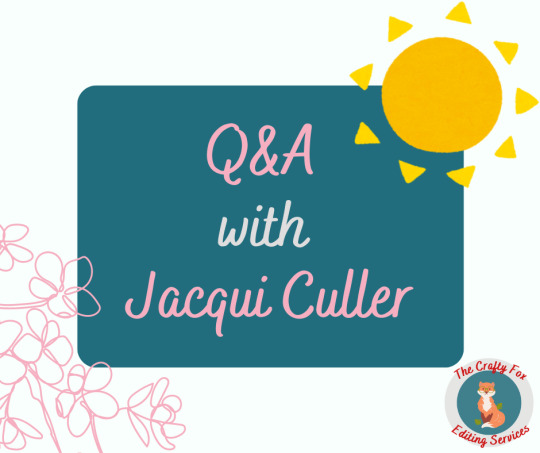
Q&A with Jacqui Culler
✨A short interview with my RevPit 2024 winner!
Hey Story Crafters,
As summer starts winding down (I know the last official day of summer is in September, but years of public school has trained me to think of Labor Day as the end of summer), I want to take the opportunity to reflect a little more on one of the bigger writing-editing events I participated in this year: RevPit 2024.
I honestly hadn’t heard of RevPit before a couple of years ago, when a board member reached out to ask if I’d like to participate as a RevPit editor. I said yes, completed the sample materials and sent them to the RevPit board, they extended an invitation for me to be a RevPit editor, and…life happened, preventing me from participating in RevPit that year. Thankfully, the board said I could still participate the following year, and I was able to serve as a first-time RevPit editor this year.
And I’m so glad I did! I’m happy I was able to interact with my fellow RevPit editors and the RevPit community through the 10Queries events on Reddit, to share the love of writing, reading, and a little of my editing expertise. Though it isn’t possible to offer a full developmental edit for free more than once a year, I’m happy I was able to do so through an event like RevPit. And I’m really glad I found a RevPit winner who was a good fit for my communication style (email only!), in addition to being a talented writer open to receiving feedback.
Which brings us to the main event of this post…
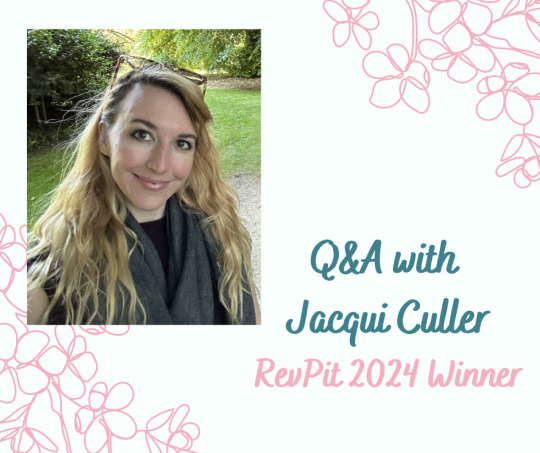
Jacqui (@CullerPictures) wears quite a few hats: she’s a YA fantasy author, works in the film industry, and also freelances as a graphic designer. She agreed to answer some questions about why she decided to enter RevPit.
You can still view Jacqui’s RevPit Showcase materials on the RevPit site: https://reviseresub.com/showcase/capers-crowns-and-thieves
1. Before deciding to enter RevPit, what was your editing process?
Before entering RevPit, my editing process had a few steps after finishing a first draft. I’d go back through the manuscript and do my own version of a developmental edit, checking where the major plot points happened and writing breakdowns for every chapter. That would help me figure out if certain scenes were truly needed, if some could be combined, and if others needed to be beefed up.
Then I’d go through and do a line edit to clean up the writing and try to get the word count down. After that, I’d read the whole thing out loud to listen to the flow of wording and dialogue and make edits while doing so.
Finally, I’d try to give the whole thing a rest for a few weeks and then give it another read-through with fresher eyes to hopefully catch any typos and story slipups.
2. Why did you choose to enter RevPit?
I had actually entered RevPit twice before with a different manuscript, and this was my third time entering. I’ve followed Revise & Resub for a few years and I love the community they’ve created online.
When I entered this year, I did so not expecting much, but I figured why not try? I was very pleasantly surprised when I got the email that said I was a winner!
3. What qualities were you looking for in your RevPit editor?
I read the profiles for all the editors that fit my genre and looked for the ones that I thought I would enjoy working with. I wanted an editor who specialized in fantasy and would tell me what was working as much as what wasn’t, as well as someone who would be encouraging along the way. Leah was all those things and more, and I’m so lucky she chose me as her winner!
4. Did you have expectations going into RevPit? If so, what were they, and how were they met?
After finding out I won, I hoped my manuscript would come out the other end being the strongest version of this story it could be. I suspected that meant ripping it apart and piecing it back together, but I was open to major changes and just excited to have Leah’s eyes on it.
Luckily, there wasn’t that much ripping involved! There were still changes I had to make, but I felt like each one worked toward that goal of telling the best story I could.
5. What did you learn about yourself as a writer from RevPit?
I learned to have a little more confidence in myself as a writer! I was prepared to face some hard truths about my writing and storytelling when I got my edit letter, and I remember the biggest thing I was surprised about was how much I’d done right!
That edit letter and this whole RevPit experience have given me a huge boost of confidence, not only in my writing abilities but also in my ability to be able to talk about my writing and what I’m working on, which is something I’ve been very shy about in the past.
6. How has your querying journey been so far?
From the RevPit Showcase, I got interest from three agents, and two of the three requested to see more of my manuscript. One was a full request and the other was a partial, and I’m currently waiting to hear back from them.
I think a huge reason why I got interest was due to how much Leah helped with my opening pages and my query letter, making sure the stakes were clear and that it hinted at the major theme of the story. I’m still sending out queries to more agents, just to cast the net a bit wider, but fingers crossed I’ll get that yes soon!
Additionally, Jacqui was kind enough to share her thoughts about working with me!
1. Did you have any concerns about working with me on your project? If so, did your concerns turn out to be true? If not, what happened instead?
When I found out I was going to get to work with Leah through Revise & Resub’s annual RevPit contest, I did zoomies around my apartment, I was so excited to work with her! It was obvious from our first communication that Leah is not only kind and professional, but 100% knows what she’s doing.
Every single word of her feedback shows how thoughtful, intelligent, and insightful she is, and that she truly wants to make your work shine. Whenever I received feedback from her, I couldn’t wait to read it because I knew her insight would help me see my story in a whole new light. My experience working with her was even better than I had hoped for, and it makes me feel incredibly lucky and grateful that she chose me as her RevPit winner.
2. What did you enjoy most about working with me? Were you pleasantly surprised at any point of the process?
I enjoyed every aspect of working with Leah, and I can’t recommend her enough. When I read through her comments on my manuscript, it was almost like I was sitting right there with her as she read it. The feedback was so insightful, encouraging (not to mention fun to read!), and each one lit up my brain with ideas of what I could do to strengthen my story.
She showed me how a reader might interpret those aspects of a story that are so easy to overlook as the person who wrote it and made enormously helpful suggestions on how to address them. From minor notes like a pesky door that I kept forgetting only opens one way, to bigger picture suggestions like making a character’s motivations much clearer, Leah got me examining every scene, every dialogue exchange, every room layout—all aspects of my manuscript—to ensure they were all working together like I intended.
3. If you recommended my editing services to a close friend, how would you explain the reasons they should hire me?
Leah can not only pinpoint what part of your manuscript or query is or isn’t working, but she can tell you exactly why. Before I started working with her, I had revised my manuscript so many times, I’d hit a wall and was fresh out of ideas on how to make it better.
After Leah sent my editorial letter, it was almost like it made my story new for me again. Every suggestion she made on my manuscript and query letter helped me either build on what was working or put me on the path to making it better. The process of working with Leah breathed new life into my story—and me as a writer.
4. What are 3 words you would use to describe your experience working with me, or my editing style?
Encouraging – Leah told me what was working and what I did well as much as what could be improved on, which gave me a huge boost of confidence. As a writer, you want to tell the best story you can and you want to feel confident that you can do that. With Leah’s encouragement I received both, and I can’t thank her enough.
Thorough – Reading through my edit letter and the Developmental Editing Tracking Sheet Leah created, I could tell she combed through every inch of my manuscript to the point that it felt like she knew the story just as well as I did—and sometimes even better! She posed questions about my setting, character motivations, and story timeline that hadn’t even occurred to me that I needed to answer.
Invaluable – Having Leah’s eyes on my manuscript and her editing talent in my corner has been invaluable. During the time I’ve worked with her, I feel like my storytelling has become stronger, and the way I think about how to construct a scene, build a setting, and develop character relationships has strengthened my writing.
5. Have you ever hired a freelance editor before? If you have, how has your experience working with me been different?
While I haven’t worked with an editor before, I can’t imagine a better experience than working with Leah. She went above and beyond to make my manuscript shine, and because of her, it’s now better than I could have possibly made it on my own.
View Jacqui's RevPit 2024 Showcase!
Next time, I’ll review what you as an author can expect from a developmental edit from me—with a few examples!
If you’ve got a finished manuscript and Jacqui’s experience working with me has you interested in my services, please visit my website or send me an email! I’m interested in hearing from fantasy, sci-fi, and horror authors, but I’m open to working with any genre if the author-editor fit is good.
Visit The Crafty Fox Editing Services!
Send me an email!
Until next time!
Best,
Leah
Connect with me on social media!
Interested in learning more about me, and the kind of energy I’ll bring to a author-editor relationship? Subscribe to this newsletter (it’s free!).
Substack Post: https://thecraftyfoxwriterscorner.substack.com/p/q-and-a-with-jacqui-culler
0 notes
Text
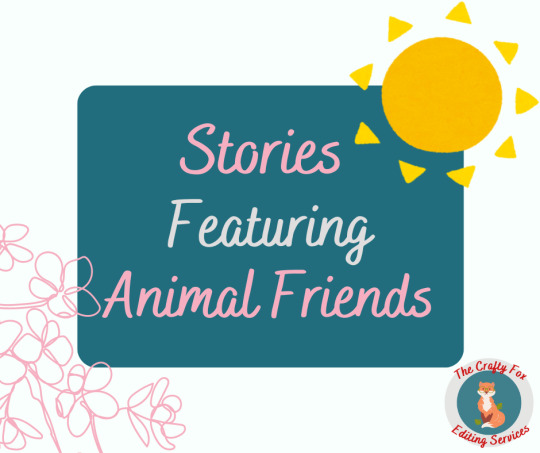
Stories Featuring Animal Friends
Some thoughts on how animal friends fit into storytelling. 🐾
Hey Story Crafters,
A lot of my favorite stories feature animal companions. It’s one of my favorite storytelling tropes—and I’m sure many of you will agree with me. I think the bond that can form between a person and an animal—the absolute trust and devotion that can develop—is a bond most people either wish they can experience for themselves, or have experienced it, and enjoy seeing other types of person-animal companion bonds develop.
If I had to trace it back to a source, it would probably be Pokémon. Or at least, that’s my earliest memory of a creature companion being featured in a story other than Disney movies. I loved watching Ash encounter new Pokémon, gradually gain their trust, become friends and then go on adventures together. I rewatch the Indigo League arc every once in a while, and I still experience that sense of wonder and get hit right in the feels while watching Ash (and Misty and Brock) interact with Pokémon. And naturally, I haven’t outgrown the need to read or watch stories that feature animal friends!
Based on the media I’ve consumed, I’d say stories featuring animals can be divided into two categories: animal companions and anthropomorphic animals. I’ll share a few examples of each below and my thoughts about them from a storytelling perspective.
Animal Companions
In some stories, the world-building creates the expectation that animal companions aren’t unusual. This is the case in Pokémon (or Pocket Monsters), where inhabitants of this story world can breed or catch wild Pokémon and train them. This then leads to the expectation that the main character’s journey will involve Pokémon: Ash’s goal is to become the greatest Pokémon master.
In other stories, animal companions may be used as part of the world-building to establish a fantasy setting, or fantasy/supernatural elements. This is true for Brian Jacques’s Castaways of the Flying Dutchman, in which an angel curses all of passengers on the pirate ship, The Flying Dutchman, with immortality. Among the passengers is a cabin boy named Ben and his dog, Ned—and because they are the only innocent souls on board, Ned is gifted a human-like consciousness and a telepathic bond with Ben. Another example is Nghi Vo’s novella, The Empress of Salt and Fortune, in which a cleric named Chih is partnered with a hoopoe named Almost Brilliant, and tasked with recording stories. In both of these stories, the connection between the main character and their animal companion serves as a reminder that fantasy, supernatural elements exist in their respective story worlds, even if nothing else fantastical happens as part of the plot.
Anthropomorphic Animals
I was a big Brian Jacques fan when I was growing up. Before I read Castaways of the Flying Dutchman, I was already hooked on his Redwall series, a fantasy children’s book series featuring anthropomorphic animal characters. For those unfamiliar with Redwall, its story world is similar to Disney’s Zootopia in that the inhabitants are divided into “good” and “bad,” with the Redwall series being more concrete about which species falls into each category: with woodland creatures like mice, otters, squirrels, hares, and badgers (“good”) vs. vermin like rats, stoats, weasels, and foxes (“bad”). Basically, it was another way of identifying the heroes vs. villains, cops vs. criminals in storytelling. This allowed Jacques to tell straightforward stories of good vs. evil using the types of characters most children identify and like to play make-believe with—animals.
Juneau Black’s Shady Hollow series also features anthropomorphic animals characters, and like other media (e.g., Redwall series, Zootopia), it doesn’t dwell on the logistics of how predators can coexist with prey animals. While a character’s animal traits may be addressed to establish setting or make observations, the focus is on solving the mystery established at the inciting incident. There is no good vs. evil, just characters living their lives and making choices to the best of their ability. A predator can be a spunky reporter like Vera Vixen, eager to sniff out a new story to publish for Shady Hollow’s local paper, and a prey animal can be the suspect—or culprit—in a crime that’s been committed.
As with any storytelling element, the relevance of the animal friend trope needs to be weighed, and woven into the storyline. If you’ve recently finished a manuscript that features animal friends, I’m the editor for you! I mostly edit fantasy, dark fantasy, science fiction, and horror, but I’m open to working in most genres if an author and I fit well together (like cozy mysteries!). Get in touch below if you’re interested in working with me.
Visit The Crafty Fox Editing Services!
Send me an email!
Until next time!
Leah
Connect with me on social media!
Substack Post: https://thecraftyfoxwriterscorner.substack.com/p/stories-featuring-animal-friends
Subscribe to my free Substack newsletter to get a writing resource!
#Writing Advice#Writing Tips#Storytelling#Animal Companions#Animal Friends#Stories Featuring Animal Friends
2 notes
·
View notes
Text

Updates from the Editor's Desk
#RevPit 2024 Showcase and a master post for The Writer's Corner.
Hey Story Crafters,
The RevPit 2024 Showcase goes LIVE TODAY at noon/12 PM EDT! Come check out the hard work all the RevPit winners put into their query letters and first 5 pages: https://reviseresub.com/showcase
If you’re interested in learning about their RevPit experience, make sure to visit the #RevPitClassof24 thread on X/Twitter, where they responded to the prompts listed below:

As a first-time RevPit editor, the entire contest (from pre-contest events all the way up to the showcase) has been an exciting, rewarding experience. I really appreciate the RevPit Board for giving me the opportunity to participate as a RevPit editor, and I’ve enjoyed getting the chance to interact with both the other RevPit editors and all of the authors in the RevPit community, and working with my contest winner, Jacqui Culler (@CullerPictures)!
As many of us continue on our writing journeys, I thought I’d put together a master post of The Writer’s Corner posts that cover craft topics.
Master Post of Craft Topics
General Writing Tips
What Makes a Story Compelling?
Point of View + Psychic Distance
Saving Multiple Drafts of Your Writing
3 Tips for Staying Inspired During the Writing Process
How to Avoid Stalling During the Writing Process
Let’s Talk Flashbacks
Time in Storytelling
Writing Tips for Characters
3 Tips for Creating a Memorable Main Character
Make Your Main Character Shine
Profile of a Main Character
Character Development: First Conflict Event
The Value of Side Characters
Looking at Character Archetype: The Strongest Character
The Wound that Haunts Characters
Creating Physical Wounds for Your Characters
Relationship Mapping Part 2
Writing Tips for Dialogue
Let’s Talk Dialogue:
Part 1
Part 2
Part 3
Writing Tips for Fight Scenes
Writing Fight Scenes Part 1
On Writing Fight Scenes: A Long Post
Example of an Effective Fight Scene: A Brief Breakdown
Post-Novel Writing Tips
On Consistency and Beginnings
Titles & Expectations
Let’s Talk About Sequels Part 1
Let’s Talk Query Letters
If you’re interested in talking with me about craft topics, or if there is any you’d like me to cover in the newsletter, get in touch! I also still have some openings for editing projects this summer, so please check out my services and send me an email if you’re interested in working with me!
Visit The Crafty Fox Editing Services
Send me an email!
I mostly edit fantasy, dark fantasy, science fiction, and horror, but I’m open to working in most genres if an author and I fit well together (like cozy mysteries!).
Until next time!
Best,
Leah
Connect with me on social media!
Interested in learning more about me, and the kind of energy I’ll bring to a writer-editor relationship? Subscribe to this newsletter (it’s free!).
Substack Post: https://thecraftyfoxwriterscorner.substack.com/p/updates-from-the-editors-desk-45a
#Writers#Writing#RevPit 2024#RevPit#Writing Tips#Craft Talk#Updates from the Editor's Desk#Writing Advice
1 note
·
View note
Text
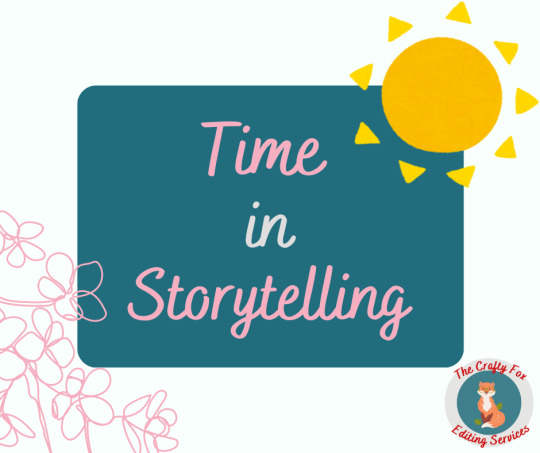
Time in Storytelling
A couple of thoughts on time in storytelling and how to track it while writing (or editing) your story.🕰️
Hey Story Crafters,
It’s the start of long, sunny days.🌞 Hope you’re enjoying the long weekend and getting the chance to spend time outdoors as the summer season starts settling in!
For this post, I want to share a couple thoughts about time and how to track it in your storytelling.
Time is pretty malleable in storytelling. You can stay in the narrative present, go backward or forward in time, lengthen a single scene into several pages, or undergo a time skip in a single paragraph break. When you think about it, messing with time in a story is a bit like magic for an author—with a few keystrokes, you can control how little or how much time has passed.
The problem with this much power (as tends to be the case with most power) is that it can be easy to lose track of how little or how much time has passed. This is especially true if you need to frequently step away from your writing for any reason (e.g., school, work, life, etc.) and you’re not quite sure where you left off in the story when you come back to it, if you’re adding more scenes to previous chapters, or if you’re editing your story.
One solution to this is to keep a timeline that spans your entire novel. Starting from Chapter 1 (or the Prologue, if you have one), make a note of how many story days pass in each chapter. This will give you a better picture of how much time passes in the story overall, and help you determine whether too little, too much, or just enough time has passed in relation to the plot. Time tends to play an important role in plotting since it usually involves a deadline the main character(s) must meet to achieve the primary goal of the story—doing so gives the story a sense of immediacy and urgency.
Time is one of the elements I keep track of in a story during a developmental edit. It’s part of the tracking sheet I include in my developmental editing package, and it’s a deliverable many of the authors I’ve worked with found really helpful for polishing their stories. If you need another set of eyes to help you track time in your novel, I might be the editor for you!
I mostly edit fantasy, dark fantasy, science fiction, and horror, but I’m open to working in most genres if an author and I fit well together (like cozy mysteries!). I still have some openings for the summer months, so please check out my services and send me an email if you’re interested in working with me!
Visit The Crafty Fox Editing Services
Send me an email!
Until next time!
Best,
Leah
Substack Post: https://thecraftyfoxwriterscorner.substack.com/p/time-in-storytelling
Connect with me on social media!
Interested in learning more about me, and the kind of energy I’ll bring to a writer-editor relationship? Subscribe to this newsletter or check out the archives!
0 notes
Text
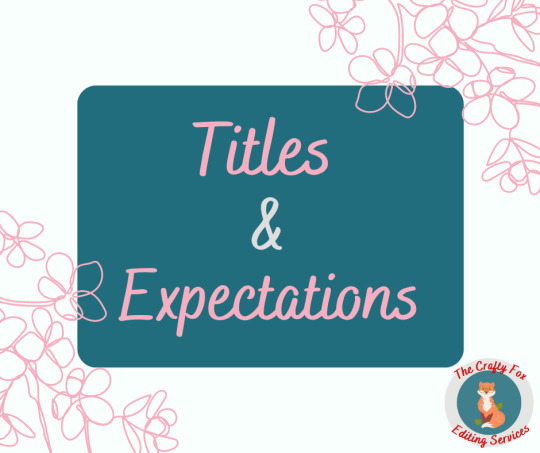
Titles & Expectations
Thoughts on matching titles to stories and meeting viewer or reader expectations.
Hi Story Crafters,
Over the past couple of weeks I’ve had the chance to watch Knuckles (the 6-episode miniseries based on the Sonic the Hedgehog franchise character) and The Fall Guy (starring Ryan Gosling and Emily Blunt), which got me thinking about titles, protagonists, and viewer expectations. These are all factors that can be applied to books, with “viewer expectations” switched out for “reader expectations,” so I wanted to touch on them in this post.
*Slight spoiler warnings for Knuckles and The Fall Guy.
One of the hardest parts of writing for me is coming up with names. Some names, like character names, need to be decided early-on, because it’s hard to write a story about characters who don’t have set names. Others, like the title of your book, can wait until the end. Usually during the process of writing your story the title naturally unfolds, so you can get away with a filler name during the WIP stage.
Titles pull a lot of weight. They encompass the entirety of the story you’re trying to tell, and also set up certain reader or viewer expectations. Knuckles, for example, sets up the expectation that the series is about the titular character, Knuckles the Echidna. In actuality, the character who seems to have the most screentime and the most development in the series is Wade Whipple, the somewhat bumbling deputy sheriff who shows up in the two Sonic the Hedgehog movies preceding this miniseries. Based on a before/after comparison of the series, Knuckles experiences very little character development. He already knows who he is (a warrior), even if he isn’t sure how that role works now that he’s on Earth. His arc is basically learning how and where he fits in his new home—he doesn’t experience a noticeable amount of change or growth. He serves as a mentor figure for Wade, who does experience a significant amount of growth on his path to becoming a warrior. By the end of the series, Wade has adopted a confident warrior mindset that puts him on equal standing with Knuckles and (hopefully) the rest of the Sonic cast.
All of this is to say that the Knuckles miniseries title and the viewer expectations (that the focus of the series will be Knuckles) don’t really line up. It’s an enjoyable show to watch, but it’s not really about Knuckles. It’s more about Wade, and to some extent, his relationship with Knuckles. So the series probably would’ve benefited more from a title that reflects the duo’s relationship.
The Fall Guy on the other hand has a title that fits the story it’s telling. The protagonist is a stunt person (Ryan Gosling’s character) who experiences a fall from grace (pun intended) at the beginning of the movie, and spends the course of the movie restoring his stunt person reputation and repairing his relationship with his love interest (Emily Blunt’s character). While accomplishing these goals, he’s also trying to avoid being framed as the fall guy for a crime he didn’t commit. So while the title is a bit on the nose, it isn’t misleading the way Knuckles could be considered.
If you’ve got a completed manuscript that’s ready for editing and you’re worried your title might not fit your story, please get in touch! I’d love to have the chance to help you with your story and brainstorm title ideas with you. I’m interested in working with authors of:
Fantasy
Dark Fantasy
Science Fiction
Horror
Send me an email!
I’m open to working in most genres if an author and I fit well together, so please get in touch if you’re interested in working with me!
Until next time!
Best,
Leah
The Crafty Fox Editing Services
Connect with me on social media!
Interested in learning more about me, and the kind of energy I’ll bring to a writer-editor relationship? Subscribe to this newsletter (it’s free!).
Link to Substack post: https://thecraftyfoxwriterscorner.substack.com/p/titles-and-expectations
#Writers#Writing#Writing Advice#Writing Tips#Titles#Reader Expectations#Viewer Expectations#Titles & Expectations
0 notes
Text

Updates from the Editor's Desk
✨A brief announcement! 🌸
Hi Story Crafters,
A short post this time!
The biggest news I have to share is that the #RevPit 2024 winners will be announced today, Monday, April 15 at noon (12 p.m.) ET! 🎉🥳

A big thank you to everyone who participated this year! There were SO MANY amazing submissions, it was hard to narrow the selection down to one finalist and one runner-up. I managed to do it…somehow.
Please remember that if you weren’t chosen, it’s not a reflection on your ability as an author. It just means that your book may need more work that the time frame allows, or it’s ready for querying.
You’re all amazing writers and I look forward to seeing where you take your books!
I’m currently busy with client work and prepping for my #RevPit winner, so no craft thoughts today. I’ll have more for you next time!
Also, if I gave feedback on your query letter + first 5 pages during my 10Queries sessions, you can expect an email from me by this weekend! Keep an eye out for it!
And, as always, if you’ve got a finished manuscript and you’re looking for an editor, please don’t hesitate to reach out!
Send me an email!
Until next time!
Best,
Leah
Substack post: https://thecraftyfoxwriterscorner.substack.com/p/updates-from-the-editors-desk
Visit The Crafty Fox Editing Services
Connect with me on social media!
0 notes
Text
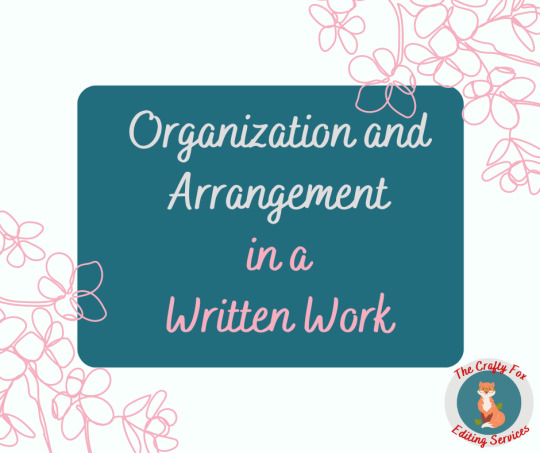
Organization and Arrangement in a Written Work
A few thoughts about macro-level organization (or arrangement) in a written work, and some RevPit news.
Hi Story Crafters,
The RevPit Editor Window opened earlier this week, so I’ve been diving deep into submissions! Some general impressions I’ve gotten during my first pass include:


Which means I haven’t had too much luck on narrowing down my submission selection… But I’m getting there! 😊
Once I’ve narrowed it down a little more, I plan to schedule my 10Queries sessions. I’ll announce the dates on Twitter/X, so stay tuned! As a reminder, the 10Queries sessions will be posted on the RevPit subr/eddit, and you don’t need to have a r/eddit account to view the public posts!
Please make sure to keep an eye out on Twitter/X and the subr/eddit for announcements from the other RevPit editors about their 10Queries sessions! I know Jeni and Miranda have already hosted one, and Natasha has set a date for one. Even if you aren’t participating in RevPit, or if your query letter + first 5 pages aren’t chosen for a 10Queries session, there is still a lot to learn from the 10Queries threads. I highly recommend reading through them!
A Few Thoughts on Organization in Manuscripts
This week, I was working on the first round of an editing project that involved rearranging a poetry collection. The project wasn’t scoped for any line or copyediting, but the client was open to having the order of their poems rearranged, or even removed if one didn’t fit with the others. It got me thinking about how the structural elements of a written piece are organized, and the effectiveness of that organization.
For this post, we’ll focus on the macro-level: poetry and short story collections, and novels.
Poetry and Short Story Collections
For poetry and short story collections, theme tends to be the deciding factor for how they’re organized. In general, broad strokes, this can look like poems of death and decay being grouped together, and then transition into rebirth and life.
Of course, this isn’t always the case. For example, in Revenge: Eleven Dark Tales by Yoko Ogawa, the link between the stories is subtle—a cameo from a character of a previous story. (Spoiler notice: It’s been a while since I read the collection, but off the top of my head, I remember the first story involves the protagonist visiting a pastry shop, and the pâtissier makes a cameo in the next story as a side character.)
Novels
There is a little more leeway and room for experimentation with organization when it comes to poetry and short story collections. With novels, chapters tend to have a set organization—in other words, the sense of the story moving forward is an expectation that determines a novel’s organization. A couple of frameworks for novels that might allow for more experimentation when it comes to chapter organization include multiple points-of-view or a nonlinear narrative.
Overall, it seems the driving factor behind organization is the sense of progression. This is usually linked to time passing in a linear fashion, since we tend to process developments (e.g., character development, relationship development, mental/emotional/physical growth, etc.) with time.
Regardless of whether this is right or wrong, it is something that readers are familiar with, and something to keep in mind while you write.
If you’ve got a manuscript that you’re working on that might need some restructuring, please don’t hesitate to get in touch! I’m interested in working with authors of:
Fantasy
Dark Fantasy
Science Fiction
Horror
I’m open to working in most genres if an author and I fit well together, so please get in touch if you’re interested in working with me!
Send me an email!
Remember to keep an eye out for announcements about 10Queries sessions! Also, please note that if your submission is used in a 10Queries session, you won’t be notified until after the editor picks are announced on April 15. If you need a refresher, the RevPit contest schedule can be found here: https://www.reviseresub.com/annual-contest/schedule.
I’ll keep working through my RevPit selection process and prepping for my 10Queries sessions! I hope to chat with some of you then.
Best,
Leah
Visit The Crafty Fox Editing Services
Connect with me on social media!
Interested in learning more about me, and the kind of energy I’ll bring to a writer-editor relationship? Subscribe to this newsletter on Substack (it’s free!).
Substack post: https://thecraftyfoxwriterscorner.substack.com/p/organization-and-arrangement-in-a
#Writers#Writing#Organization#Arrangement#Writing Advice#Thoughts#RevPit#RevPit 2024#Announcements#Organization and Arrangement in a Written Work
1 note
·
View note
Text

Diving into #RevPit submissions…
0 notes
Text
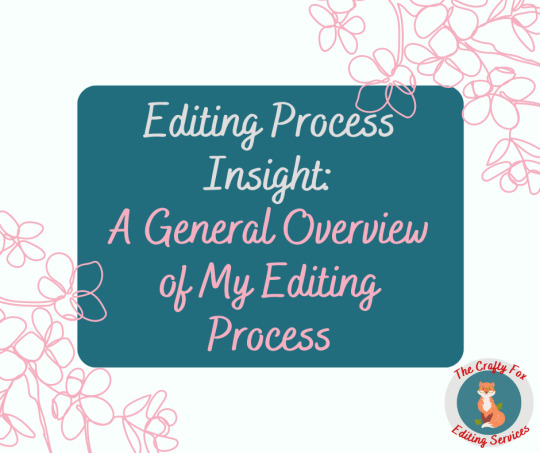
✨Editing Process Insight: A General Overview of My Editing Process
A brief overview of how I start working on a fiction editing project. 🌸
Hey Story Crafters!
If you’ve been keeping up with my Twitter/X feed or with Revise & Resub news, you’ll know that the submission window for #RevPit 2024 officially closed at noon | 12 p.m. yesterday!
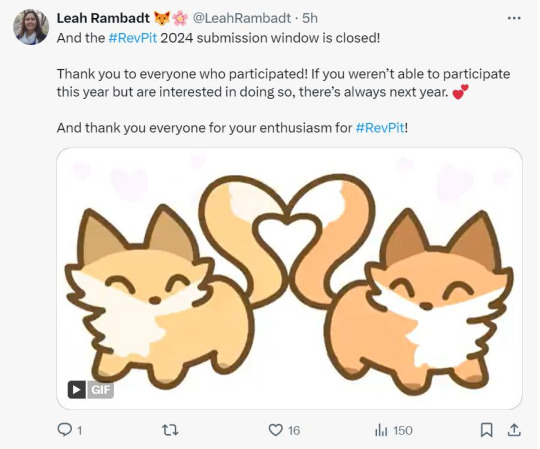
For those interested in keeping up with the #RevPit excitement—whether or not you decided to participate this year—there are daily activities you can join in on or observe during the (excruciating) waiting period.
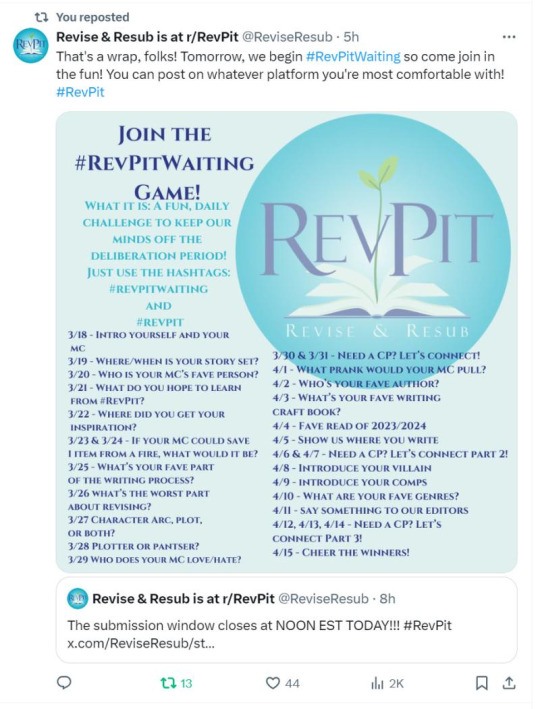
Or you can stay up-to-date by following Revise & Resub on Substack, @ReviseResub on Twitter/X, or r/RevPit on r/eddit.
My Editing Process
In preparation for my #AskTheEditor session, I decided to share a bit of how I approach a new fiction editing project here. And I’m going to do it by comparing my editing approach to one of my hobbies—LEGO building.
My LEGO-building process
I’ve been building LEGOs for a long time, since the first versions of the Millennium Falcon, the Imperial Star Destroyer, and the Death Star II were in circulation—back when the instructions came in one giant, spiralbound booklet (which made it really easy to rip the pages) and none of the bags were numbered. Just picture it: bins and bowls filled with countless pieces of various shapes and sizes, primarily in black and several shades of gray. Sorting through the pieces was more time-consuming than actually building the models.
Since I built those models in middle school—before I refined my LEGO-building process—I can’t say whether or not there was a pattern to how the pieces were packaged. As I got older and LEGO started numbering their bags to make the sorting and building experience more enjoyable, I noticed that there is a pattern to the packaging. Which meant I no longer had to follow the unofficial first steps shown in all the LEGO building instruction booklets: dump out the pieces and sort them. (This was a big relief to my mom, who no longer had to loan out leftover containers or baking trays for my hobby.)
Now, my process is pretty simple:
Unpack the instruction booklet and all the bags.If it’s a big build and the bags are numbered, I organize the bags and put them back in the box in reverse order, so the higher numbered bags are on the bottom.
Start building. I open the bags and pull out the pieces I’ll need to complete the steps on the pages I have open.
In the process of pulling pieces out of the bags and building, I figure out how the pieces are packaged across the bags. So as long as I don’t mangle the bag upon opening, I can keep all the pieces in the bag instead of dumping the pieces out.
Repeat until done. (And sink into a sort of meditative state.)
So, my LEGO-building process is pretty streamlined, and I can reach the finished build relatively quickly (like, over a few days or less, time-wise).
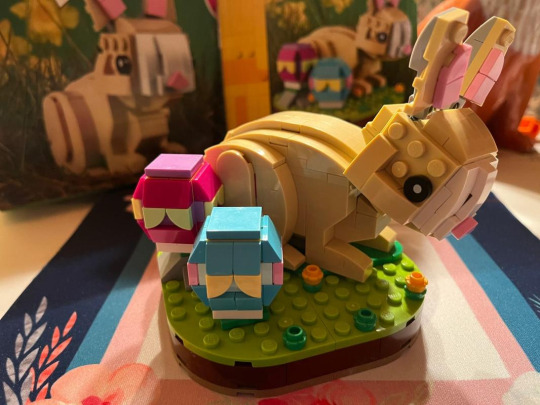
Caption: Photo of LEGO 40463 Easter Bunny build. Alt-text: Photo of a small LEGO build of a cute brown bunny next to a couple of Easter eggs on a green base with flowers.
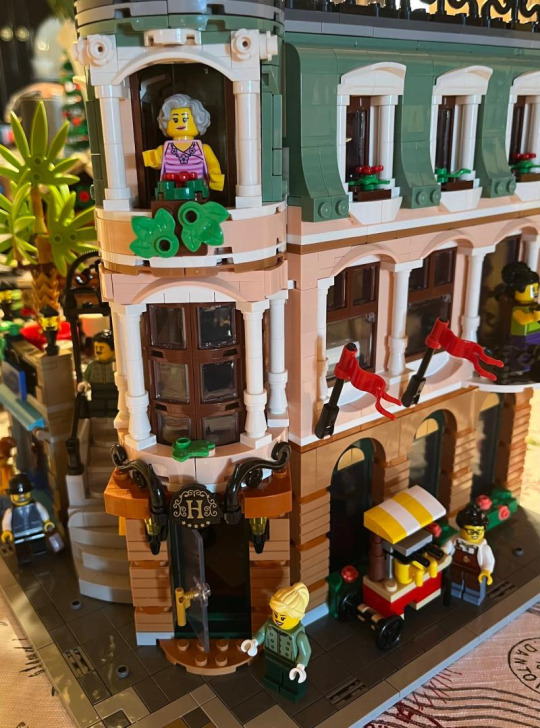
Caption: Photo of LEGO 10297 Creator Expert Boutique Hotel. Alt-text: Photo of a LEGO build of a hotel made of pink and green pieces.
Back to my editing process…
While I’ve been building LEGOs much longer than I’ve been editing fiction, my ability to refine that process gives me confidence as I continue to develop my editing process. It still undergoes a few tweaks now and then, as I learn how to improve my process with each author I work with.
But the way I start a fiction editing project is the same:
Upon receiving the manuscript (MS) in a Word file, I make a folder for the new project and save all the relevant files for the project (e.g., a developmental editing project folder includes the manuscript with markups, the dev editing tracking sheet, and the editorial letter).
Make sure the MS is formatted to industry standard (i.e., 1-inch margins, 12-point Times New Roman, double-spaced, page numbers).
Apply the “Heading” style to chapter titles to make navigation easier.
Start editing.
Communication
My method of communication is email, all the way.
Email is the best communication method for me to keep in contact with authors and other clients. It makes it easier for me to track what we discussed and when, so I can refer back to an earlier conversation if needed and expand on it.
I’m pretty responsive. I make sure to respond to current clients within 24 hours on weekdays. (I don’t usually respond to emails I receive over the weekend unless a current client has an emergency.)
During a fiction editing project, I have 3 standard emails:
At the start of the project. I send an email to the author saying that I’ve started editing their MS, and that I’ll reach out if I have any questions. I also remind the author to reach out if they have any questions, concerns, or need to share additional information about their MS.
A week before the return date. This email is meant to reassure the author that everything is on track to be returned on the date agreed upon per the contract (which we both agreed to and signed prior to the project start date).
The return date. The editorial package is returned to the author, with a reminder that the author has up to 30 days after the return date to send up to 10 emails to discuss the edits.
Frequency of communication
The frequency of the email communication can vary from author to author. I’ve worked with authors who I didn’t contact outside of the 3 standard emails (and a few follow-up emails), and were perfectly fine with that level of communication. I’ve also worked with authors who preferred weekly check-ins. When I start working with a new author, we decide on which level of communication works best for them and stick with it throughout the duration of the project.
#RevPit 2024 #AskTheEditor sessions
This week the #AskTheEditor sessions for #RevPit 2024 start up! My session is this Thursday, March 21 at 7 p.m. ET on r/eddit. If you’re interested in learning more about my editing process, please drop in! You don’t need to have a r/eddit account to view public threads, so if you want to take a peek at upcoming events like #10Queries, please feel welcome to!
Link: Ask the Editor chats r/eddit thread
If my editing process sounds compatible with your workstyle, please don’t hesitate to get in touch! I’m interested in working with authors of:
Fantasy
Dark Fantasy
Science Fiction
Horror
though I’ve also worked on cozy mysteries too. I’m open to working in most genres if an author and I fit well together, so please get in touch if you’re interested in working with me!
Send me an email!
And that’s it for this week! I hope to chat with some of you on Thursday!
Best,
Leah
Visit The Crafty Fox Editing Services!
Connect with me on social media!
Substack post: https://thecraftyfoxwriterscorner.substack.com/p/editing-process-insight-a-general
#Writers#Editing#Editing Process#Editing Process Insight: A General Overview of My Editing Process#RevPit#RevPit 2024#AskTheEditor
0 notes
Text
Please make sure to drop in for the #RevPit #AskTheEditors sessions that are starting this week! 🌸
Here is the r/eddit link and schedule:
Mine is on Thursday, March 21 at 7 PM ET! I hope to chat with some of you then. 😊
Just a reminder: You DON’T need a r/eddit to drop in and view any of the public #RevPit sessions, like the upcoming #10Queries events!
0 notes
Text
And the #RevPit 2024 submission window is closed!
Thank you to everyone who participated! If you weren’t able to participate this year but are interested in doing so, there’s always next year. 💕
And thank you everyone for your enthusiasm for #RevPit!
1 note
·
View note
Text
Boosting!
The #RevPit 2024 submission window is open! 🎉

View the post link here:
https://x.com/reviseresub/status/1768306833284894792?s=46&t=jIkStnxyKeaXgs-crC42IA
Or head over to the submission page on the #RevPit website!
The submission window is open until noon | 12 PM ET on Sunday, March 17!
Friendly reminder that you DON’T need to be on r/eddit to participate in #RevPit, or to drop in on the upcoming #AskTheEditor and #10Queries sessions.
1 note
·
View note
Text
The #RevPit 2024 submission window is open! 🎉

View the post link here:
https://x.com/reviseresub/status/1768306833284894792?s=46&t=jIkStnxyKeaXgs-crC42IA
Or head over to the submission page on the #RevPit website!
The submission window is open until noon | 12 PM ET on Sunday, March 17!
Friendly reminder that you DON’T need to be on r/eddit to participate in #RevPit, or to drop in on the upcoming #AskTheEditor and #10Queries sessions.
1 note
·
View note
Text
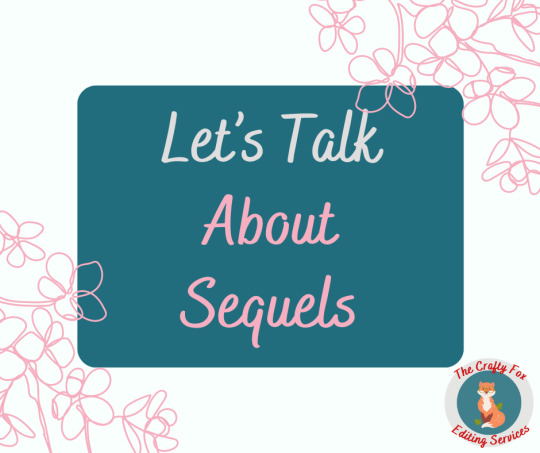
Let's Talk About Sequels Part 1
Some opening thoughts about sequels and a couple of announcements! 🌸
Hey Story Crafters!
I wasn’t feeling well last weekend, so I wasn’t able to send out a post like I originally planned. I ended up binge-watching several movies—as one does while on bed (or couch) rest—and a couple in particular got me thinking about sequels: 22 Jump Street and Shrek 2.
Now, the type of humor in the Jump Street movies isn’t my cup of tea. (I don’t tend to like comedy movies, or at least live action ones, in general. On the manga/anime side, Gintama, Gekkan Shoujo Nozaki-kun, and Sakamoto desu ga? have the kind of humor I enjoy.) I stumbled into 21 Jump Street by way of autoplay after dozing off, and then stuck through to the end of the second one out of a combination of morbid curiosity and just being in a haze of unwell. By the end of it I wanted to watch a movie with a more satisfying sequel, and hopped over to Shrek and Shrek 2.
Before we talk about the elements that make up a satisfying sequel, let’s take a look at the transition or lead-in to the sequel—in other words, the first work’s ending. When a work has series potential, the ending will leave the reader or viewer with a sense of anticipation (“What happens next?”) that the sequel is expected to fulfill.
This can be played out in a couple of ways:
Cliffhanger. It’s clear that the first work’s ending is a pause to build up tension for the sequel. At the end of 21 Jump Street, Schmidt and Jenko are told they’ll be undercover in a college for their next assignment. A couple of book examples include For the Wolf by Hannah Whitten, which ends with a character getting sent to another world; and Godkiller by Hannah Kaner, where the main character (MC)—presumed dead by the other characters—regains consciousness and prepares to continue on her quest.
Setting the expectation of progression. This can be through:
Time: The MC gets older, usually by a year. Think the Percy Jackson & the Olympians series by Rick Riordan, where the next book is the next year at camp. Or just any series where the MC needs to progress through grade levels at school, etc.
Life milestones: Yes, this technically falls under “time,” but I made it separate because the mental/emotional stakes are a little different. The MC or MCs achieve a life goal in one work, with the expectation that another life goal will be the focus of the sequel. This happens in Shrek, where the happily ever after is achieved (relationship-wise = the marriage to true love), and leads into Shrek 2, where the MC’s focus is on keeping or making the happily ever after work (a.k.a. actual married life post-honeymoon phase).
These are just a couple of techniques that came to mind. Feel free to share others you can think of in the comments!
An exception to the sequel lead-in
An exception to the sequel lead-in is the mystery genre, whodunits especially. Think of detective characters like Sherlock Holmes, Hercule Poirot, or Benoit Blanc (from the Knives Out movies)—they don’t tend to experience the kind of character arc we expect in most fiction. These characters are brilliant investigators who don’t usually experience any internal change; instead, they’re placed at the scene of a new crime or mystery to solve. We’re less concerned about learning to care about the detective character, and more interested in finding out how the victim over there ended up with a knife in his back when the room is sealed and there isn’t a blade in sight.
That’s not to say mystery novels can’t have MCs with character arcs (Vera Vixen from the Shady Hollow series comes to mind). It’s just not as much of an expectation for them.
We’ll stop here for this post. Stay tuned for future discussions about sequels!
Now, onto a couple of announcements.
New posting schedule
Due to changes in my work schedule, The Writer’s Corner will be updating every other week!
#RevPit 2024: #MeetTheEditors
This week, all participating #RevPit editors will be hosting live chat sessions on Reddit so authors can get to know them! I’ll be hosting my session this Thursday, March 7, at 6 p.m. ET. Even if you’re not participating in #RevPit 2024, please feel free to drop in!
If you’re looking for an editor, this session is a great way to learn more about me, and to see if we’ll work well together! I’m interested in working with authors of:
Fantasy
Dark Fantasy
Science Fiction
Horror
though I’ve also worked on cozy mysteries too. I’m open to working in most genres if an author and I fit well together, so please get in touch if you’re interested in working with me!
Send me an email!
For the #RevPit 2024 contest schedule, please visit https://reviseresub.com/annual-contest/schedule. You can also find more information about the #RevPit contest, and ways to stay up-to-date with the contest on social media.
I’m still not too familiar with Reddit, and I’m equal parts excited and nervous about my session. As a sort of icebreaker, I plan to have this small LEGO built by Thursday.
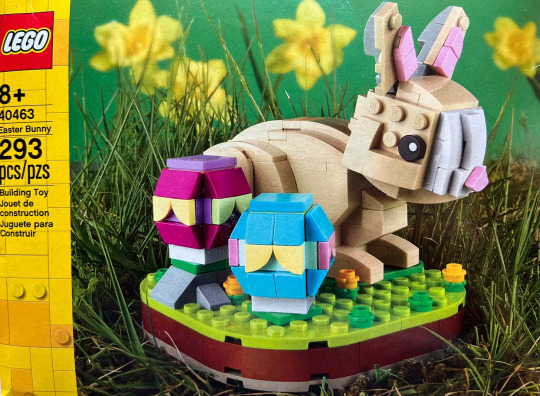
Photo of LEGO 40463 Easter Bunny box.
Alt text: Photo of LEGO 40463 Easter Bunny box. A small build with a cute brown bunny next to 2 easter eggs and small flowers on a green base.
I’ll share pics of the finished build during my Meet the Editor session!
I hope to chat with some of you on Thursday! 😊
Best,
Leah
Visit the Crafty Fox Editing Services
Connect with me on social media!
Substack Post: https://thecraftyfoxwriterscorner.substack.com/p/lets-talk-about-sequels-part-1
Interested in learning more about me, and the kind of energy I’ll bring to a writer-editor relationship? If you're a writer, consider subscribing to my free Substack newsletter.
You can also check out the archives.
#Writers#Writing#Sequels#Sequel#Let's Talk About Sequels Part 1#Let's Talk About Sequels#Updates#News
0 notes
Text
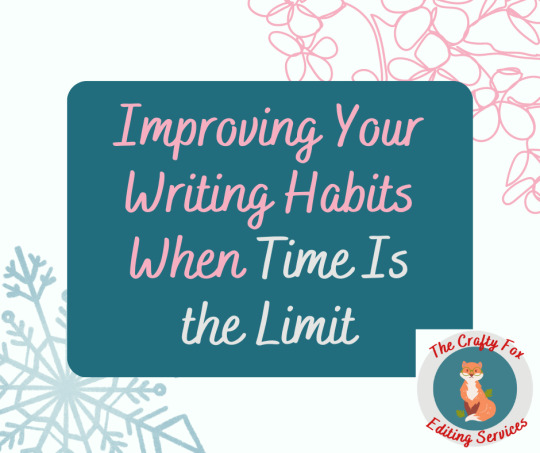
Improving Your Writing Habits When Time Is the Limit
A few tips for getting some writing in when you don’t have a lot of time.
Hi Story Crafters,
This is a little late, but happy 2024! I hope everyone had a wonderful holiday season, and spent some time relaxing and recharging the writing part of their brain.
I’d like to start off by thanking all of my current subscribers for their continued support of this newsletter—I couldn’t publish these posts without you! Please bear with me as I get back into the habit of sending out this newsletter more frequently and consistently.
As a way to get back into the swing of things (me with the newsletter, and maybe you, with your writing), this post will be a remix of a couple of my earliest posts:
5 Tips for Developing a Daily Writing Habit
Developing a Daily Writing Habit Recap: Taking a Break
Now for the remix:
I’ve found the tips below (a few of which may sound familiar) helpful with improving my own writing habits over the past few weeks. Hopefully, you find a couple of them useful too!
✨Try to write every day.
Try to write every day, even if it’s just 1 sentence or even just a fragment of one. Sometimes the hardest part of writing is just starting. As long as you have something written on the page, you can build on it; and it might feel easier to do so as the days go by!
✨Write ugly—or, you know, have fun!
Don’t worry too much about connecting sentences or even ideas together. Don’t worry if they’re in chronological order, if there are repetitive words, etc. Some days getting words on the page will feel like pulling teeth; on others, you’ll feel like everything is falling in place, and the writing will be fun. In any case, just set the goal of getting your thoughts and ideas down—or if you’re feeling up to it, a whole scene!
✨Try to have 1-2 days a week where you can sit down and write.
Try to have 1-2 days where you can sit down with the ideas, sentences, and/or fragments you wrote over the course of the week and try to connect them. This might take the form of writing a paragraph, a scene, or even an entire chapter. The goal is to weave everything into a cohesive story. Often I end up writing more and writing longer than planned, so I try to set aside a big chunk of time.
✨Try to read what you previously wrote before you start writing again.
Reading what you last wrote (which, hopefully, was the day before) can help rev up the writing part of your brain, making you excited to keep on writing and/or giving you ideas on how to keep writing. They’re pretty much the same thing, honestly. Try not to edit too much when you use this technique, unless doing so will help you continue writing the current narrative.
✨Find inspiration wherever possible.
This could mean watching movies or TV shows that are the same genre as your writing project, or share similar characters, plot devices, or other story elements. This might mean researching certain topics like historical events, investigative techniques, first aid techniques, fight scenes, etc. And it might also mean finding techniques you’d like to use in your own writing, like comedic dialogue, tragic narratives, certain plot twists etc.—though in this case, you’ll want to find examples of books that use those techniques effectively, so you can analyze how the authors pulled off those techniques.
That’s all I’ve got for now! I’ve also got some news for this spring…
❇️ Upcoming Event: #RevPit 2024
If you’ve got a finished manuscript and are planning to pursue traditional publishing, consider submitting your manuscript to this year’s #RevPit! Manuscripts of all genres, audiences, and lengths are welcome. I’ll be participating as a #RevPit editor this year alongside several other fantastic editors.
In the months leading up to #RevPit there will be events where you can meet the editors and even submit your query package for brief feedback (You can check out the most recent #10Queries event here.)
Check out the event schedule below:
Twitter/X: https://x.com/reviseresub/status/1747255382320533918?s=46&t=jIkStnxyKeaXgs-crC42IA
Please remember that all #RevPit events have been moved to Reddit! You can find the #RevPit event Reddit post here.
Until next time!
Best,
Leah
Visit the Crafty Fox Editing Services
Connect with me on social media!
Substack Post: https://thecraftyfoxwriterscorner.substack.com/p/improving-your-writing-habits-when
Interested in learning more about me, and the kind of energy I’ll bring to a writer-editor relationship? If you're a writer, consider subscribing to my free Substack newsletter (you can check out the archives, too). You'll get a free writing resource on relationship mapping, and a special offer when you subscribe!
You can also check out the archives.
Are you searching for an editor to work with on a completed (or soon-to-be-completed) manuscript? Get in touch! I’d love to hear about your project(s). I’m looking to work with authors of:
Fantasy
Dark Fantasy
Science Fiction
Horror
Send me an email!
1 note
·
View note